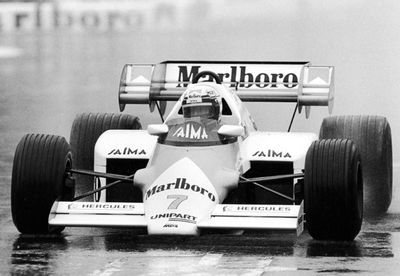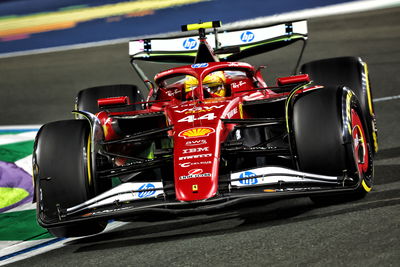In memory of... 1984

Formula One history is full of parallel pasts. Narratives are re-written with new characters, cycles of dynasties and dominance play themselves out as revolving doors of supremacy, and the incessant progress and expansion of Grand Prix racing is underpinned by a core cast of recurring names, nations and circuits.
The 2014 season has been defined by the dominance of one team, Mercedes, and the ebb and flow of the increasingly bitter feud between Lewis Hamilton and Nico Rosberg as they contest an internal battle for the World Championship.
A single team and driver enjoying a huge performance advantage over their rivals is nothing new, and nor is the idea of two drivers from two different teams fighting tooth and claw for the World Championship. However, the notion of two equally matched drivers within a dominant team fighting an exclusive battle for the championship is surprisingly rare.
1996 saw Damon Hill pip rookie Williams team-mate Jacques Villeneuve to the championship at the season's final round, but the battle was rarely enthrallingly close - either on the track or in the standings. Alain Prost and Ayrton Senna's epochal title fights of 1988 and 1989 at McLaren are perhaps the most famous examples of intra-team rivalry, but the iconic standing of the characters, the level of dominance and the ultimately destructive fallout of the narrative are without comparison in F1 history. 1955 also saw the fight between two team-mates go to the wire as Juan-Manuel Fangio took the title from Mercedes stable partner Stirling Moss, but Moss's championship challenge was a token gesture.
There was though one other season which, like 2014, saw two team-mates, one a world champion and the other a multiple race winner, fight a closed-doors battle for the championship that went to the very last; a battle defined by a contrast in styles and discrepancies in reliability, fought out in a dominant car powered by a V6 turbo engine that returned a team to dominance from the doldrums, and played out against a backdrop of controversial new regulations in the name of efficiency. Niki Lauda and Alain Prost's battle for the 1984 championship at the wheel of the McLaren-TAG MP4/2 may not resonate with the same degree of tumultuousness as the Senna and Prost years, but the parallels between 1984 and 2014 are arguably stronger - and the lessons of the past highly prescient for Hamilton and Rosberg as they head into the second half of the season.
1984 marked the fourth season of McLaren's ownership by Ron Dennis, and fortunes had steadily improved from the podium-free nadir of 1980 after Dennis's Project Four Racing operation merged with the ailing McLaren team. Three consecutive race-winning seasons and a championship challenge from John Watson in 1982 set the tone for the fledgling Dennis era, and for 1984 McLaren's prospects were improved by a new chassis, the MP4-2, and the first full season of turbo engines in the team's history.
1983 marked the turning point of Formula One's first turbo era, with Nelson Piquet the first driver to win the World Championship powered by a turbo engine. As improved reliability increasingly rendered the notoriously volatile turbo engines a viable option, so turbo power became a requirement for peak competitiveness. McLaren's first such power unit was also the turbo era's first great engine: the TAG/Porsche TTE PO1 1.5 V6t.
TAG, an acronym of Luxembourg-based holding company Techniques d'Avant Garde, had first entered F1 as a sponsor of Williams in 1980. After Ron Dennis offered TAG the opportunity to acquire part-ownership of McLaren, they financed the development of turbocharged Porsche V6 engines for McLaren's exclusive use in 1984. Welded to the MP4-2 monocoque as part of an integrated design process, chassis and engine rapidly proved themselves both quick and reliable.
The most crucial ingredients, and the key players in the narrative, were of course the drivers. Niki Lauda was a 35 year-old veteran of two World Championships, two 'permanent' retirements and 19 race wins across his 13 years in the sport. The straight-talking Austrian was as characteristically blunt and curmudgeonly then as he is now, but he was also still a very quick driver, and retained his capacity for outstanding technical feedback and car development.
Forming something of a 'chalk and chalk' partnership with Lauda was Alain Prost, the 29 year-old Frenchman rejoining McLaren after three seasons at Renault - during which time he had established himself as one of Formula One's most complete drivers. Like Lauda, Prost had a reputation for being outspoken, and had been fired by Renault after publicly criticising the team's lack of development throughout his ultimately fruitless championship challenge in 1983. Also, like Lauda, Prost was an exceptionally intelligent driver. His smoothness behind the wheel was already a defining trait, but the 'tortoise and hare' perception that would come to define Prost's driving style later in his career was yet to take shape.
On the track, the season would prove to be a tour de force for McLaren, with Prost, Lauda and the reliable performance of the MP4-2 TAG dominating proceedings to an extent hitherto unseen in Formula One. The team scored 12 victories from 16 races, smashing the previous team record of eight wins in a single season achieved by Lotus in 1978. Prost also equalled Jim Clark's 1963 record for wins in a single season, taking the chequered flag seven times in total.
In a time before bulletproof reliability became the norm for leading teams, dominance was rarely measured by statistical oppression to the extent that we now take for granted. With tightened regulations reducing the amount of fuel permitted during a race from 250 litres to 220 for 1984, the balance between power and efficiency was particularly difficult for most teams to strike - and the season holds the record for the lowest average finishes in F1 history, with just 40.9% of race starts completing full distance. McLaren still suffered 11 retirements from 32 race starts, but compared to their rivals' repeat failings this was borderline invincibility.
These failings were especially prevalent in defending World Champion Nelson Piquet, whose Brabham-BMW was the outright fastest car in the field over a single lap - taking a record-equalling nine pole positions - but also the most fallible, suffering five straight engine failures to start the season and breaking down nine times in all. McLaren's happy marriage of speed and reliability was summed up by Clive James, who famously quipped, "anything as fast as the McLarens fell apart, anything as reliable finished later".
The McLarens were still capable of demonstrating extraordinary supremacy on occasion though - particularly on gas-guzzling high-speed circuits where the efficiencies of the TAG engine were even more pronounced. Lauda and Prost scored four 1-2 finishes during the year, including lapping the entire field in South Africa, there were only three occasions where McLaren finished a race off the podium.
Given the pedigree of the contenders, it is no surprise that the fight between Prost and Lauda went the full distance. Each scored over double the points of third-placed challenger Elio de Angelis, and this was very much a private battle that dominated the narrative of the year. It was also a season of two halves, with Lauda suffering six retirements in the first half of the campaign (four mechanical, two driver error) to Prost's solitary breakdown in Belgium, and Prost subsequently enduring four retirements in the second half of the season as Lauda strung together an impeccable sequence of six podiums and three wins from seven races.
The iconography of the campaign is usually summed up in the classic Monaco Grand Prix, cut short at half distance for Prost to take a half-points victory from the hard-charging Ayrton Senna and Stefan Bellof, but there were other races to remember along the way. The season's reputation for high attrition can perhaps be best summed up by the back-to-back demolition derbies of the Detroit and Dallas Grands Prix in mid-season. In Detroit, Nelson Piquet led home a field of only five finishers as the narrow concrete circuit and warm conditions caused repeat failures by both man and machine. Two weeks later, Keke Rosberg scored the first victory for Honda's turbo effort by guiding his Williams to victory as one of eight drivers to survive sweltering conditions and a disintegrating circuit around the narrow streets of Dallas.
Neither McLaren would play a prominent role in the narrative of the American double-header, but from Dallas onwards the McLarens were irrepressible - winning seven straight races to the end of the season. Unlike in years such as 2009 or 1998 where a fast-starting team were caught in a development race, the gap between McLaren and their rivals grew as the year wore on. Prost took four wins to Lauda's three down the stretch, but with the lion's share of misfortune suddenly rearing its head on Prost's side of the garage, it was literally a win or bust second half for the Frenchman.
Prost had led the championship from the off after winning the opening race in Brazil, and held a 10.5 point cushion at the halfway stage of the season, but Lauda made a decisive move to the top of the standings after round 12 with a first home victory in Austria. A Prost-Lauda 1-2 for McLaren at the next race in the Netherlands secured the inevitable Constructors' title for McLaren and narrowed Prost's deficit to 1.5 points with three races to spare.
Engine failure at Monza at the very next race looked to have de-railed Prost's chances for good though. Lauda took the win and extended his advantage to 10.5 points with two races to spare. Given that Lauda had finished no lower than second at any race thus far, and was enjoying a streak of fine reliability, Prost's chances of overcoming the shortfall to secure his maiden title seemed slim. Nothing less than victory at the remaining two races would be good enough, and Prost's chances hinged on Lauda rediscovering some of his early-season fallibility.
Poignantly, round 15 took place at the revised N?rburgrung, and marked both F1's and Lauda's first return to the scene of his infamous 1976 accident. In typically no-nonsense fashion Lauda declared himself untroubled by the sentimental weight of the past, but he delivered a subdued performance - qualifying 15th and taking fourth place for his lowest finish of the season while Prost streaked to victory, setting up a championship showdown at Estoril.
Four times Formula One had seen the title settled by a one point margin, most recently then when Nelson Piquet pipped Carlos Reutemann to the 1981 championship, but the statistical quirk of Prost's 4.5 points for his half-distance Monaco win meant that there were multiple permutations that could see the closest finish to a championship in F1 history. Both Prost and Lauda had lost out on a championship at the final round before, but Lauda held the advantage heading to Portugal: finish second, and the Austrian would be guaranteed of becoming Formula One's third three-time champion.
Despite only qualifying 11th, with Prost starting second to pole-sitter Piquet, Lauda was, as so often that season, able to climb his way through the field during the race through a combination of attrition, aggressive overtaking, wily racecraft and the outright speed of the McLaren. When Nigel Mansell spun out of second place with 18 laps to go, Lauda inherited the position he needed to take the title, irrespective of Prost's victory. The Frenchman won the battle but lost the war, beating Lauda home by 13 seconds but losing out on the title by the narrowest margin in Formula One history - just half a point.
Had the race in Monaco run to full distance and Prost finished only second, the title would still have been his. Instead he suffered the agony of last-race heartbreak for the second consecutive year, despite taking seven victories to Lauda's five. The denouement looked to confirm Prost's destiny as F1's perennial 'nearly man'. He had taken 16 wins across five seasons since his debut, more than any other driver during that period (including double World Champion Nelson Piquet), yet had been unable to clinch the title his burgeoning talents so clearly deserved.
Given that Lauda would only beat Prost on the road twice in trouble-free races all season, it was sheer consistency that hauled him back in to contention, and his third title, especially one taken by fighting the fading of the light against a rival approaching the prime of his career, secured his place among the all-time greats of F1.
So what portents from 1984 can be applied to 2014? Lauda's powers of recovery from lowly grid positions, reversal of fortunes in the luck stakes through the second half of the season and ability to capitalise whenever his team-mate suffered misfortune are attributes that Lewis Hamilton would love to carry through to the end of the year as he chases down the faster-starting Nico Rosberg.
If the 2014 season does go to the wire, it will be double points rather than half points for which the conclusion will be remembered - but the stakes will be equally high for two team-mates in a league of their own. For Mercedes, this season is already a cakewalk to team success in the Constructors' standings, but the battle between their drivers promises to be as fiercely fought to the bitter end as that between Prost and Lauda thirty years ago.
Will Saunders@formulawill











